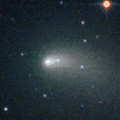
|
Now it is very bright as 9.5 mag (Jan. 4, Neil Norman). It will go far away from Earth after this. But it will approach to Sun down to 0.58 a.u. on Feb. 21. In the Northern Hemisphere, it will be getting lower rapidly after this, and it will be extremely low in February. In the Southern Hemisphere, it is not observable until late March.
Date(TT) R.A. (2000) Decl. Delta r Elong. m1 Best Time(A, h)
Jan. 13 23 7.85 52 33.5 0.331 1.022 87 10.7 18:38 (131, 53)
Jan. 20 22 20.07 39 5.2 0.495 0.912 66 11.2 18:44 (115, 38)
|
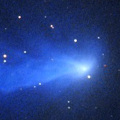
|
Now it is bright as 10.5 mag (Jan. 6, Neil Norman). It will stay bright as 11 mag for a long time until spring. In the Southern Hemisphere, it stays observable in good condition until February. In the Northern Hemispehre, it stays observable for a long time after this until the comet fades out.
Date(TT) R.A. (2000) Decl. Delta r Elong. m1 Best Time(A, h)
Jan. 13 4 11.67 17 41.6 2.129 2.878 131 11.2 20:40 ( 0, 73)
Jan. 20 4 6.13 19 43.8 2.182 2.848 123 11.2 20:07 ( 0, 75)
|
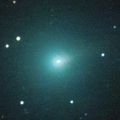
|
Now it is very bright as 10.4 mag (Dec. 15, Marco Goiato). It is observable in good condition in the Northern Hemisphere. It locates low in the Southern Hemisphere. It will be fading after January.
Date(TT) R.A. (2000) Decl. Delta r Elong. m1 Best Time(A, h)
Jan. 13 13 41.03 2 29.6 1.167 1.526 90 11.3 5:38 (345, 56)
Jan. 20 13 54.01 2 3.3 1.147 1.560 93 11.6 5:37 (351, 57)
|
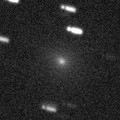
|
Now it is 13.8 mag (Jan. 1, Ken-ichi Kadota). It will brighten very rapidly, and brighten up to 11 mag from January to February. In the Northern Hemisphere, it stays observable for a long time in the evening sky. In the Southern Hemisphere, it locates extremely low at the highlight.
Date(TT) R.A. (2000) Decl. Delta r Elong. m1 Best Time(A, h)
Jan. 13 22 17.47 -7 29.0 1.449 0.959 41 11.8 18:38 ( 64, 21)
Jan. 20 22 48.77 -5 59.7 1.411 0.941 41 11.4 18:44 ( 65, 22)
|
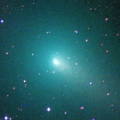
|
It brightened up to 8.1 mag in autumn (Oct. 3, Juan Jose Gonzalez). Now it is fading. It has already faded down to 12.2 mag (Dec. 23, Carlos Labordena). It is observable all night in the Northern Hemisphere. In the Northern Hemisphere, it stays observable in excellent condition for a long time. In the Southern Hemisphere, it will never be observable again after this.
Date(TT) R.A. (2000) Decl. Delta r Elong. m1 Best Time(A, h)
Jan. 13 1 37.67 85 7.2 1.352 1.941 111 12.7 18:38 (179, 40)
Jan. 20 2 40.57 84 28.1 1.425 2.000 110 13.1 18:48 (180, 41)
|
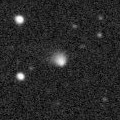
|
Now it is 13.6 mag (Dec. 18, Toshihiko Ikemura, Hirohisa Sato). It is expected to brighten up to 12 mag from 2018 to 2019. In the Northern Hemisphere, it stays observable in good condition while the comet will be brightening gradually. In the Southern Hemisphere, it is not observable until 2018 October.
Date(TT) R.A. (2000) Decl. Delta r Elong. m1 Best Time(A, h)
Jan. 13 15 46.40 56 50.3 3.103 3.289 92 13.2 5:38 (218, 56)
Jan. 20 15 47.25 59 19.9 3.004 3.248 95 13.1 5:37 (211, 57)
|

|
It brightened up to 7.1 mag from May to June in 2017 (June 21, Juan Jose Gonzalez). Now it is fading. It has already faded down to 13.5 mag (Jan. 5, Chris Wyatt). In the Southern Hemisphere, it stays observable for a long time after this. It will never be observable again in the Northern Hemisphere.
Date(TT) R.A. (2000) Decl. Delta r Elong. m1 Best Time(A, h)
Jan. 13 21 35.36 -53 15.2 3.838 3.134 38 13.4 18:38 ( 35,-16)
Jan. 20 21 52.91 -52 24.8 3.916 3.201 38 13.5 18:44 ( 38,-17)
|
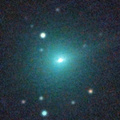
|
Now it is 12.0 mag (Dec. 18, Seiichi Yoshida). It is observable in good condition in the Northern Hemisphere. It locates very low for a long time in the Southern Hemisphere. It will be fading after this.
Date(TT) R.A. (2000) Decl. Delta r Elong. m1 Best Time(A, h)
Jan. 13 15 12.72 -7 2.9 1.507 1.413 65 13.6 5:38 (319, 39)
Jan. 20 15 29.31 -8 8.4 1.508 1.459 67 14.3 5:37 (322, 39)
|
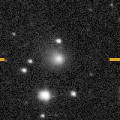
|
Now it is 13.7 mag (Nov. 14, Gabor Santa). It is expected to brighten up to 10 mag in summer in 2018. In the Northern Hemisphere, it stays observable until 2018 summer while the comet will be brightening. However, it will be extremely low from December to January. In the Southern Hemisphere, it is hardly observable in 2017, but it will be observable in good condition in 2018.
Date(TT) R.A. (2000) Decl. Delta r Elong. m1 Best Time(A, h)
Jan. 13 18 29.39 6 26.7 3.995 3.210 32 13.8 5:38 (270, 11)
Jan. 20 18 36.33 5 33.3 3.924 3.158 34 13.7 5:37 (274, 15)
|

|
Now it is 14.4 mag (Dec. 29, Kunihiro Shima).
Date(TT) R.A. (2000) Decl. Delta r Elong. m1 Best Time(A, h)
Jan. 13 21 43.75 -11 2.9 6.609 5.799 32 13.8 18:38 ( 67, 12)
Jan. 20 21 48.88 -10 33.3 6.664 5.798 26 13.8 18:44 ( 72, 7)
|
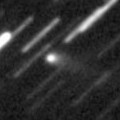
|
Now it is 13.7 mag (Jan. 12, Chris Wyatt). It stays 14 mag for a while. In the Southern Hemisphere, it stays observable in good condition until spring in 2018. It is getting higher gradually also in the Northern Hemisphere.
Date(TT) R.A. (2000) Decl. Delta r Elong. m1 Best Time(A, h)
Jan. 13 2 0.29 -35 40.8 1.890 2.006 82 14.2 18:38 ( 2, 20)
Jan. 20 2 8.57 -30 40.0 1.933 2.013 80 14.2 18:44 ( 8, 24)
|
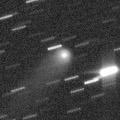
|
Now it is 13.9 mag (Dec. 13, Kunihiro Shima). It will be observable at 14 mag for a long time from 2017 to 2018. In the Southern Hemisphere, it will be hardly observable after this. It will be extremely low from November to December in the Northern Hemisphere.
Date(TT) R.A. (2000) Decl. Delta r Elong. m1 Best Time(A, h)
Jan. 13 16 35.42 25 17.7 4.064 3.744 64 14.3 5:38 (268, 44)
Jan. 20 16 36.55 26 49.0 3.970 3.739 69 14.3 5:37 (269, 50)
|
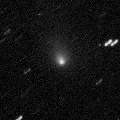
|
It brightened very rapidly up to 13.8 mag in August (Aug. 22, kunihiro Shima). After that, it is fading gradually. Now it is 15.0 mag (Dec. 19, Martin Masek). It is observable in excellent condition in the Southern Hemisphere. It stays low for a while in the Northern Hemisphere.
Date(TT) R.A. (2000) Decl. Delta r Elong. m1 Best Time(A, h)
Jan. 13 0 31.98 -15 13.7 2.490 2.337 69 15.5 18:38 ( 29, 35)
Jan. 20 0 40.75 -13 6.3 2.544 2.316 65 15.6 18:44 ( 36, 34)
|
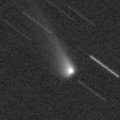
|
Now it is 15.6 mag (Dec. 13, Toshihiko Ikemura, Hirohisa Sato). It stays observable at 15-16 mag for a long time from 2017 to 2018.
Date(TT) R.A. (2000) Decl. Delta r Elong. m1 Best Time(A, h)
Jan. 13 0 10.58 -1 24.0 4.518 4.272 69 15.6 18:38 ( 44, 44)
Jan. 20 0 11.03 -2 0.2 4.646 4.276 62 15.6 18:44 ( 52, 39)
|
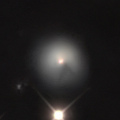
|
Brian Skiff found a bright outburst on Dec. 7. It brightened up to 13.2 mag (Dec. 11, Seiichi Yoshida). It stays bright as 13.8 mag still now (Dec. 23, Chris Wyatt). This is the 4th outburst following those in January 2006, May 2011 and August 2016. It stays observable in good condition for a while.
Date(TT) R.A. (2000) Decl. Delta r Elong. m1 Best Time(A, h)
Jan. 13 2 35.40 11 19.5 7.030 7.386 107 15.8 19:05 ( 0, 66)
Jan. 20 2 35.94 11 24.7 7.160 7.404 100 16.1 18:44 ( 4, 66)
|

|
Now it is 16.5 mag (Dec. 29, Kunihiro Shima). It stays 16-17 mag for a long time from 2016 to 2019. It stays near by the equator.
Date(TT) R.A. (2000) Decl. Delta r Elong. m1 Best Time(A, h)
Jan. 13 10 33.48 4 30.6 8.872 9.582 134 15.9 3:05 ( 0, 59)
Jan. 20 10 32.65 4 44.0 8.796 9.585 141 15.9 2:37 ( 0, 60)
|
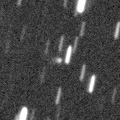
|
Now it is 16.5 mag (Dec. 15, Toshihiko Ikemura, Hirohisa Sato). It will brighten up to 9 mag in 2018 summer. However, it is hardly observable when it is bright. In the Northern Hemisphere, it is observable only until March when it brightens up to 14 mag. In the Southern Hemisphere, it is observable from July to September in 2018, but it locates in extremely low.
Date(TT) R.A. (2000) Decl. Delta r Elong. m1 Best Time(A, h)
Jan. 13 23 2.90 53 6.8 2.877 2.990 86 16.1 18:38 (134, 53)
Jan. 20 23 15.71 50 59.7 2.868 2.906 82 15.9 18:44 (130, 50)
|

|
Now it is 16.5 mag (Dec. 17, Toshihiko Ikemura, Hirohisa Sato). It stays 17 mag in 2018.
Date(TT) R.A. (2000) Decl. Delta r Elong. m1 Best Time(A, h)
Jan. 13 3 12.50 -0 42.0 6.013 6.443 111 16.0 19:41 ( 0, 54)
Jan. 20 3 12.89 -0 26.1 6.145 6.474 105 16.1 19:14 ( 0, 55)
|
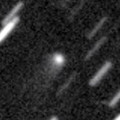
|
Now it is 15.3 mag (Dec. 28, Kunihiro Shima). It stays 16 mag for a long time from 2017 to 2018. It is observable in excellent condition in the Northern Hemisphere. It locates very low in the Southern Hemisphere.
Date(TT) R.A. (2000) Decl. Delta r Elong. m1 Best Time(A, h)
Jan. 13 8 32.40 36 3.7 4.401 5.341 161 16.0 1:05 (180, 89)
Jan. 20 8 23.32 37 24.3 4.399 5.345 162 16.0 0:29 (180, 88)
|
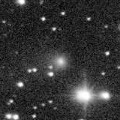
|
Now it is 15.3 mag (Dec. 17, Toshihiko Ikemura, Hirohisa Sato). It will be fading after this. In the Northern Hemisphere, it stays observable in the northern sky for a long time. It is not observable at all after this in the Southern Hemisphere.
Date(TT) R.A. (2000) Decl. Delta r Elong. m1 Best Time(A, h)
Jan. 13 20 19.35 63 19.5 3.330 3.394 85 16.0 18:38 (148, 32)
Jan. 20 20 27.34 64 11.8 3.367 3.416 84 16.1 18:44 (150, 30)
|
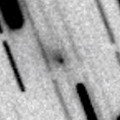
|
Now it is 17.0 mag (Dec. 19, Toshihiko Ikemura, Hirohisa Sato). It will be getting lower after this, and it will be unobservable in February. It will appear in the morning sky in April. In the Southern Hemisphere, it will be observable at 16.5 mag in good condition from spring to summer. It will be low in the Northern Hemisphere. Mikhail Maslov reported that it looks bright as 13 mag with a large coma by his photo on Dec. 19.
Date(TT) R.A. (2000) Decl. Delta r Elong. m1 Best Time(A, h)
Jan. 13 22 50.80 17 37.9 1.889 1.662 61 16.1 18:38 ( 82, 43)
Jan. 20 22 49.62 14 48.1 2.017 1.629 53 16.1 18:44 ( 84, 34)
|

|
Now it is 16.5 mag (Dec. 17, Toshihiko Ikemura, Hirohisa Sato). It will be observable at 16 mag in good condition from winter to spring.
Date(TT) R.A. (2000) Decl. Delta r Elong. m1 Best Time(A, h)
Jan. 13 11 59.91 8 32.8 2.998 3.537 115 16.3 4:31 ( 0, 63)
Jan. 20 12 0.82 8 43.5 2.908 3.537 122 16.2 4:05 ( 0, 64)
|
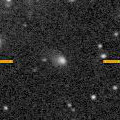
|
Now it is 15.8 mag (Dec. 25, Kunihiro Shima). It is expected to brighten up to 13-14 mag from 2018 to 2019. In the Northern Hemisphere, it stays observable in good condition for a long time. In the Southern Hemisphere, it is not observable until summer in 2018.
Date(TT) R.A. (2000) Decl. Delta r Elong. m1 Best Time(A, h)
Jan. 13 19 9.51 39 15.9 5.102 4.707 61 16.3 5:38 (236, 21)
Jan. 20 19 14.07 38 53.9 5.070 4.663 60 16.2 5:37 (238, 25)
|

|
It stays 15 mag from 2018 to 2019, and it will be observable for a long time in the Southern Hemisphere. In the Northern Hemisphere, it will never be observable again.
Date(TT) R.A. (2000) Decl. Delta r Elong. m1 Best Time(A, h)
Jan. 13 14 1.23 -49 28.5 5.357 5.104 69 16.4 5:38 (351, 5)
Jan. 20 14 4.82 -50 57.5 5.237 5.068 74 16.3 5:37 (355, 4)
|
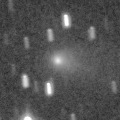
|
Now it is 15.6 mag (Dec. 19, Toshihiko Ikemura, Hirohisa Sato). It brightened rapidly. It is observable in good condition in the Northern Hemisphere. It locates low in the Southern Hemisphere.
Date(TT) R.A. (2000) Decl. Delta r Elong. m1 Best Time(A, h)
Jan. 13 4 58.48 39 32.3 1.391 2.247 141 16.4 21:27 (180, 85)
Jan. 20 4 58.60 39 6.9 1.470 2.279 135 16.7 21:00 (180, 86)
|
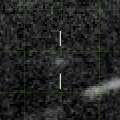
|
Now it is 17.4 mag (Dec. 18, Kim Breedlove). It will be observable at 14 mag in good condition from spring to summer.
Date(TT) R.A. (2000) Decl. Delta r Elong. m1 Best Time(A, h)
Jan. 13 16 17.67 -28 23.6 2.490 1.931 45 16.7 5:38 (318, 12)
Jan. 20 16 37.56 -29 10.8 2.408 1.897 48 16.5 5:37 (320, 13)
|
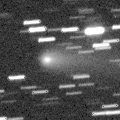
|
It brightened up to 12.2 mag in August (Aug. 21, Juan Jose Gonzalez). It is fading now. It has already faded down to 16.2 mag (Dec. 25, Kunihiro Shima).
Date(TT) R.A. (2000) Decl. Delta r Elong. m1 Best Time(A, h)
Jan. 13 7 39.83 16 43.8 1.406 2.388 175 16.5 0:13 ( 0, 72)
Jan. 20 7 31.95 17 45.4 1.467 2.444 171 16.7 23:32 ( 0, 73)
|
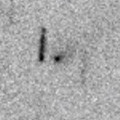
|
Now it is 16.8 mag (Dec. 20, Toshihiko Ikemura, Hirohisa Sato). It will be observable at 16.5 mag in good condition in winter.
Date(TT) R.A. (2000) Decl. Delta r Elong. m1 Best Time(A, h)
Jan. 13 9 56.57 -13 18.3 2.222 2.963 131 16.7 2:28 ( 0, 42)
Jan. 20 9 53.75 -14 14.3 2.202 2.996 136 16.7 1:58 ( 0, 41)
|
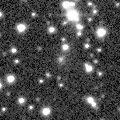
|
Now it is 16.5 mag (Dec. 18, Toshihiko Ikemura, Hirohisa Sato). It will pass the perihelion in 2019. However, it has not been brightening since the discovery in 2010. It is observable in good conditioin in the Northern Hemisphere. It is not observable for a long time in the Southern Hemisphere.
Date(TT) R.A. (2000) Decl. Delta r Elong. m1 Best Time(A, h)
Jan. 13 6 5.49 76 50.2 8.202 8.784 123 16.8 22:35 (180, 48)
Jan. 20 5 57.63 76 46.2 8.223 8.773 121 16.8 22:00 (180, 48)
|
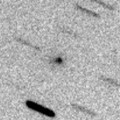
|
Now it is 17.1 mag (Dec. 21, Katsumi Yoshimoto). It stays observable at 17 mag in good condition for a while. It will be fainter than 18 mag in May.
Date(TT) R.A. (2000) Decl. Delta r Elong. m1 Best Time(A, h)
Jan. 13 14 33.79 -7 4.8 2.319 2.261 74 16.9 5:38 (330, 43)
Jan. 20 14 43.48 -7 28.4 2.268 2.292 78 17.0 5:37 (335, 44)
|
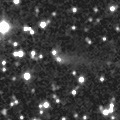
|
Now it is 16.9 mag (Dec. 13, Toshihiko Ikemura, Hirohisa Sato). In the Northern Hemisphere, it will be observable at 17 mag in excellent condition from autumn to winter. It locates low in the Southern Hemisphere.
Date(TT) R.A. (2000) Decl. Delta r Elong. m1 Best Time(A, h)
Jan. 13 5 2.71 35 22.3 2.466 3.310 143 17.0 21:31 (180, 90)
Jan. 20 5 0.91 35 5.0 2.547 3.331 136 17.1 21:02 (180, 90)
|
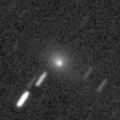
|
Return of a new periodic comet which brightened up to 13 mag in 2004. It brightened rapidly up to 14.3 mag (Nov. 15, Catalina Sky Survey). Now it is fading. It has already faded down to 16.6 mag (Dec. 19, Kunihiro Shima).
Date(TT) R.A. (2000) Decl. Delta r Elong. m1 Best Time(A, h)
Jan. 13 2 42.87 22 13.9 1.307 1.913 112 17.1 19:13 ( 0, 77)
Jan. 20 2 52.28 23 20.2 1.399 1.941 107 17.4 18:54 ( 0, 78)
|
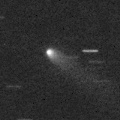
|
Now it is 16.9 mag (Dec. 13, Toshihiko Ikemura, Hirohisa Sato). It will be fading after this, and it will be fainter than 18 mag in March.
Date(TT) R.A. (2000) Decl. Delta r Elong. m1 Best Time(A, h)
Jan. 13 1 12.67 18 32.2 2.887 3.071 91 17.1 18:38 ( 41, 70)
Jan. 20 1 18.72 19 0.9 2.998 3.086 85 17.3 18:44 ( 55, 66)
|

|
It will brighten up to 16 mag in spring. In the Southern Hemisphere, it stays observable until August, but it will be unobservable after that. In the Northern Hemisphere, it stays unobservable until June, but it will be observable in good condition after that.
Date(TT) R.A. (2000) Decl. Delta r Elong. m1 Best Time(A, h)
Jan. 13 16 5.86 -41 15.1 2.373 1.869 48 17.3 5:38 (328, 3)
Jan. 20 16 30.47 -43 2.3 2.273 1.812 50 17.2 5:37 (329, 2)
|
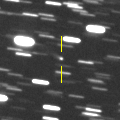
|
Now it is 16.9 mag (Dec. 22, Toshihiko Ikemura, Hirohisa Sato). It stays observable at 18 mag for a long time until 2019.
Date(TT) R.A. (2000) Decl. Delta r Elong. m1 Best Time(A, h)
Jan. 13 6 2.78 17 47.7 7.037 7.955 157 17.2 22:31 ( 0, 73)
Jan. 20 5 57.26 17 35.4 7.090 7.952 149 17.3 21:58 ( 0, 73)
|
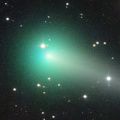
|
It brightened up to 6.2 mag in April (Apr. 7, Juan Jose Gonzalez). Now it is fading rapidly. It has already faded down to 15.5 mag (Dec. 20, Thomas Lehmann). It stays observable for a long time after this.
Date(TT) R.A. (2000) Decl. Delta r Elong. m1 Best Time(A, h)
Jan. 13 2 44.17 15 29.2 3.112 3.583 110 17.3 19:13 ( 0, 71)
Jan. 20 2 46.27 15 33.6 3.289 3.658 104 17.5 18:48 ( 0, 71)
|
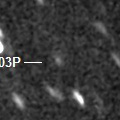
|
Now it is 18.2 mag (Dec. 19, Toshihiko Ikemura, Hirohisa Sato). It will be fading slowly after this.
Date(TT) R.A. (2000) Decl. Delta r Elong. m1 Best Time(A, h)
Jan. 13 12 2.54 -13 56.3 2.629 3.048 105 17.4 4:34 ( 0, 41)
Jan. 20 12 1.48 -14 8.0 2.579 3.098 112 17.5 4:05 ( 0, 41)
|
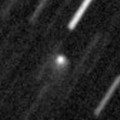
|
Now it is 17.8 mag (Nov. 23, H. Nohara). It was observed at 17 mag in former 2017. It will be observable at 18 mag in good condition from winter to spring.
Date(TT) R.A. (2000) Decl. Delta r Elong. m1 Best Time(A, h)
Jan. 13 12 53.12 5 30.6 5.065 5.360 102 17.8 5:24 ( 0, 60)
Jan. 20 12 51.32 6 42.0 4.963 5.380 110 17.8 4:55 ( 0, 62)
|
|
![]()
 C/2015 XY1 ( Lemmon )
C/2015 XY1 ( Lemmon ) C/2015 ER61 ( PanSTARRS )
C/2015 ER61 ( PanSTARRS ) 103P/Hartley 2
103P/Hartley 2 C/2017 D3 ( ATLAS )
C/2017 D3 ( ATLAS )![]()




































